{Click on an image to enlarge, then use the back button to return to this page}
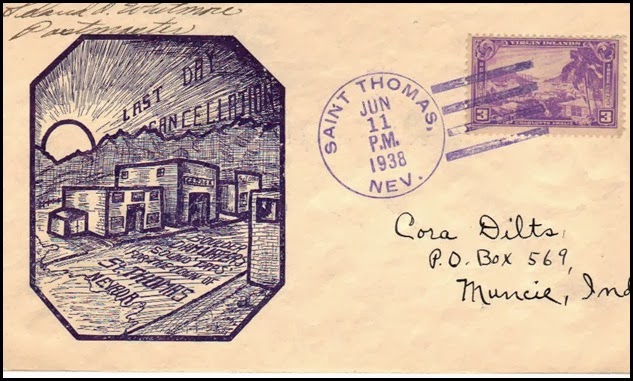 |
| (Fig. 01) |
|
 |
| (Fig. 02) |
Email received from Tom Geiger, Exton, PA:
“I just found your photo blog and gallery in my quest for information on St Thomas, Nevada. I have owned the cover and it's contents for about 40 years, when I was collecting covers as a teen. I kept it all these years because I found the story and attachments intriguing. I thought you would enjoy seeing them. The small photo, news clipping and note from "Sterling" were all enclosed in the envelope. The date coincides with the last known occupancy of the town. The cachet (drawing) on the cover shows the post office next to the garage, which doesn't coincide with your map. I'd believe your map since the drawing may have just been for artistic license. The postmaster was Edward Whitmore, and that family name appears on the lower left of the map.”
 |
| (Fig. 03) |
|
|
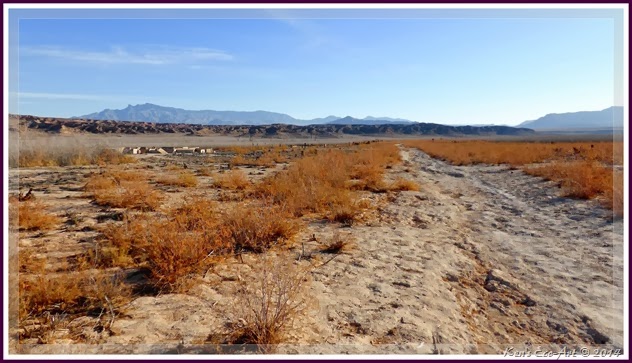 |
| (Fig. 04) |
|
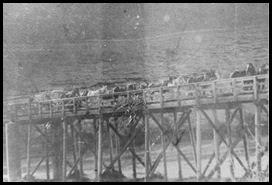 |
| (Fig. 05) |
Brief Town History: Though the Mormons settled the town around 1865, they left in the 1870’s due to a boundary dispute that placed the town in Nevada. Circa the 1880’s, noticing that the soil was good for farming, new settlers began to arrive at the town site. During this period, the peak population of St. Thomas was around 500 people. There was a school, post office, grocery stores, church, ice cream parlor, and several garages for the new invention of the automobile. What St. Thomas did not have was indoor plumbing or electricity. But memories written by the former townspeople were of a happy and simple life. In later years, St. Thomas also became popular as a stopover on the Arrowhead Trail; the first automobile road from Los Angeles to Salt Lake City. Later known as Highway 91, (Fig. 04) is a view of highway as it passed down through the center of town. I believe the bridge crossing over the Virgin River, as seen in (Fig. 05), was located just south of the town. Refer to the section “Highway 91” below. Once the Boulder Dam was completed in 1935, it took four years for the newly created Lake Mead to fully cover the town, eventually to a depth of nearly 60 feet of water. In the ensuring 60 years the waters retreated nine times, exposing some of the town's remains. However, since 2002, a 13-year drought has kept the town completely exposed ever since. Refer to “Lake Mead Water Levels” at the bottom of this post.
|
01/16/2014 Trip Notes: Even though I have made two previous visits here, the last being 04/05/2012, I decided to make yet another visit with the rock-hounds from Henderson’s Heritage Park Senior Facility. Back in December, I received an interesting email from a person in Pennsylvania with the two attachments above (Figs. 01 & 02). Though there really isn’t a lot to see here, I still find it amazing that you get to walk through the remains of a town that was once covered by nearly 60 feet of water (refer to “Lake Mead Water Levels” below). On this visit I was armed with a better map (Fig. 03) showing the layout for many of the towns more prominent buildings. Armed with this map I was better able to identify more of the exposed foundation remains. Though it is very difficult to be 100% sure about the following foundation/building identifications - I have made them by judging their relationship on the map to various foundations that I am sure of. In addition to the building foundations (The Gentry Hotel, Home of Sam Gentry, The Public Schoolhouse, Home of Wally Frenner & Lizzie Gibson, and the Hannig Ice Cream Parlor) identified on my previous page (St. Thomas, Nevada), here are some additional ones that I was able to identify on today’s visit.
|
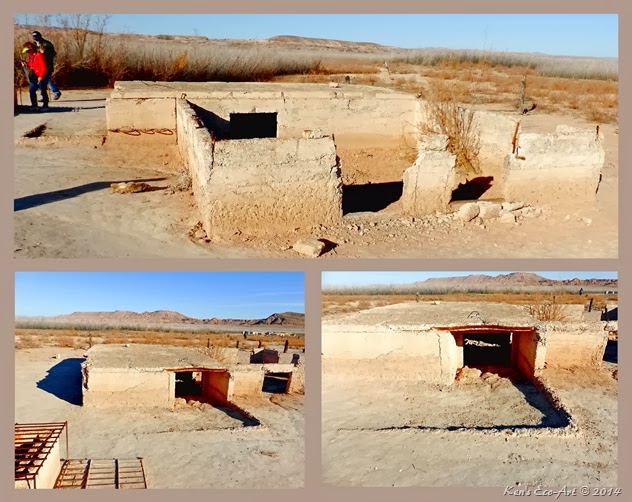 |
| (Fig. 06) Fenton Whitney Home (Map #11) |
|
| |
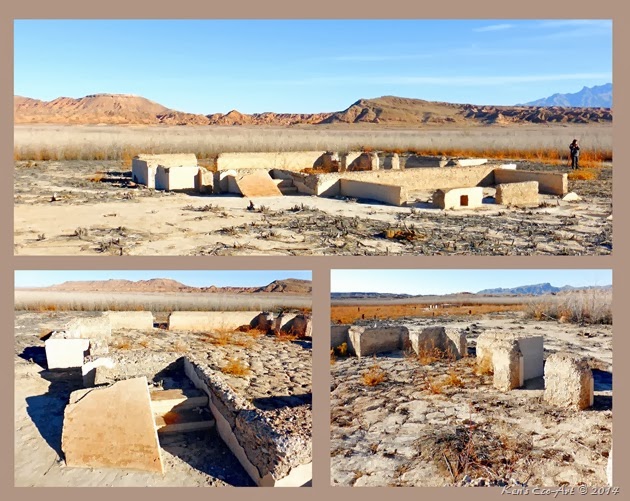 |
| (Fig. 07) New Frehner Home (Map #10) |
|
| |
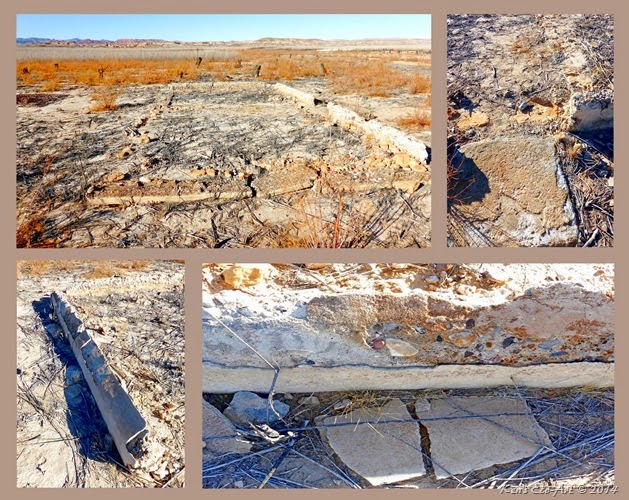 |
| (Fig. 08) R. E. Bunker Home (Map #13) |
|
| |
 |
| (Fig. 09) Ed Syphus Home (Map #14) |
|
| |
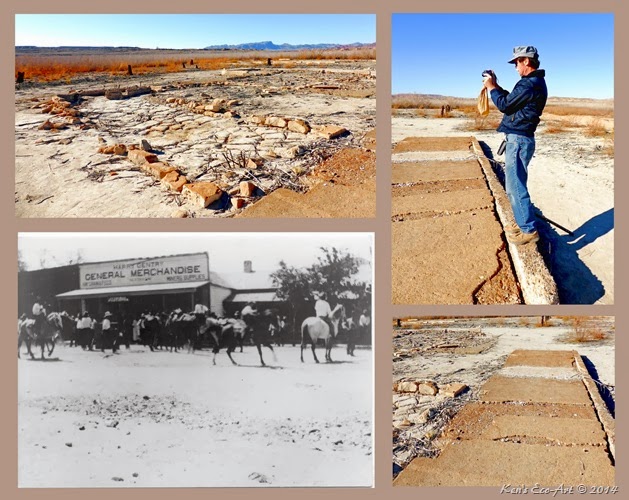 |
| (Fig. 10) Harry Gentry General Merchandise Store (Map #35) |
|
| Harry Gentry, an Englishman, was one of the earliest settlers in St. Thomas. Not only did he build the Gentry Hotel, the first modern building in St. Thomas, he also built the General Merchandise store. From what I can tell, he was the father of Samual Gentry. He died in St. Thomas in 1921 and his body was disinterred in 1934, when the flood waters of Lake Mead began to cover St. Thomas. |
| |
| Lake Mead Water Levels: Faced with a continued water shortage, federal authorities this year will for the first time decrease the amount of water that flows into Lake Mead from Lake Powell, 180 miles upstream. This action will reduce even further the level of Lake Mead. Lake Mead has dropped by nearly 100 feet since the current drought began back in 2000. This action will bring current water levels, now about 1,105 feet, to within striking range of the rationing level of 1,075 feet. Officials say there is a 50-50 chance that by 2015, Lake Mead’s water will be rationed to states downstream. That, too, has never happened before. Lake Mead currently stands about 1,105 feet above sea level, and is expected to drop another 20 feet in 2014. This continued decline would introduce a new set of problems. At 1,075 feet, rationing begins; at 1,050 feet, a more drastic rationing regime kicks in, and the uppermost water intake for Las Vegas shuts down. At 1,025 feet, rationing grows more draconian; at 1,000 feet, a second Las Vegas intake runs dry. |
| |
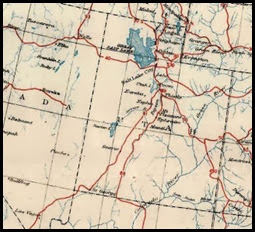 |
| (Fig. 11) |
Highway 91: In 1926, when the federal highway numbering system was established, the Arrowhead Trail became Highway 91. From what I can read, Highway 91 followed the same route as the Arrowhead Trail. The road ended in Long Beach, and to the north it went as far as Alberta, Canada. Here is a map (Fig. 11) of the original Highway 91 from 1926. Click here to read more … The Arrowhead Trail. Map Photo courtesy of www.wchsutah.org/roads/highway-91.htm |
|











